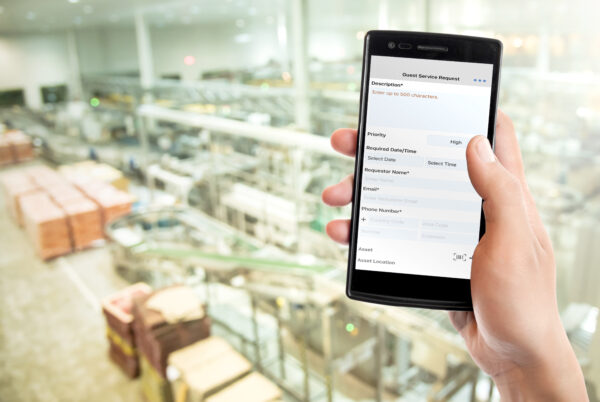
When searching for a computerized maintenance management system (CMMS), buyers must consider not only how it meets today’s maintenance needs, but future needs as well. Failure to do so may result in costly CMMS replacements, inefficient operations, and limit the benefits the software is supposed to deliver. This article shows how to evaluate a CMMS to ensure it can scale effectively as your company grows.
What is Scalability?
In CMMS software, scalability is the system’s ability to grow with your organization without slowing down, becoming unreliable, or significantly increasing costs. This growth may involve handling more data, adding users, or expanding access to additional locations and devices.
A scalable CMMS can handle an increasing amount of work orders, users, and other maintenance data without sacrificing performance and efficiency. It ensures that your system is future-proof and will support your operations as your organization grows.
How to Evaluate CMMS Scalability
Understanding how to evaluate the scalability of a maintenance management system helps you select a solution that will benefit your organization now and in the years to come. Let’s take a look at the key factors of CMMS software that affect scalability.
Number of Users
As your organization grows, the CMMS will need to accommodate an increasing number of end users. Depending on your industry and structure of your organization, this may include maintenance staff, requesters, work order approvers, contractors, compliance personnel, and other stakeholders. A scalable CMMS should support your user base without performance issues, and allow you to easily add and manage new users over time.
Number of Devices & Platform Support

Depending on the industry or type of organization, users may access the CMMS from a variety of devices. Most modern systems provide mobile access through dedicated mobile apps, available for smartphones and tablets, while other teams may primarily use desktops or laptops. A scalable CMMS allows many users to connect simultaneously from different platforms without slowing down or affecting usability.
Mobile CMMS apps typically focus on the core tasks technicians need in the field, such as viewing work orders, recording labor, or scanning barcodes. Meanwhile, the full desktop version provides access to advanced features and administrative settings. A scalable CMMS ensures that, regardless of the device or platform, users have real-time access to accurate data and a consistent experience as the number of connected devices grows.
Number of Assets Maintained
Maintenance teams can be responsible for maintaining anywhere from a handful to thousands of assets, including equipment, vehicles, and facilities. A scalable CMMS makes it easy to track, maintain, and report on a growing number of assets without compromising performance or hitting any database limits. Because you will be tracking maintenance over time, the system should be able to generate and manage large volumes of work orders tied to each asset.
As organizations grow, organizing asset data becomes as important as the number of assets being tracked. A CMMS should help mirror real-world structures using parent-child relationships, systems and subsystems, or groupings. In addition, it should allow for custom data fields to capture unique information like warranty information, compliance requirements, or condition ratings without slowing down the database. Together, these features ensure that your system works as your asset base increases in size and complexity.
Number of Inventory Items
Like assets, maintenance teams are responsible for managing a high volume of unique inventory items – sometimes tens or hundreds of thousands. A CMMS should support large inventories without performance issues, while allowing items to be organized by location, category, and vendor for quick identification and retrieval.
To make managing such a large dataset more efficient, scalable CMMS software automates key inventory management tasks. This includes updating stocking levels, notifying staff when quantities run low, generating reorder lists based on reorder points, and tracking purchasing activity. By reducing administrative work, these features make it easier to manage inventories and ensure parts are always available when needed.
Data Capacity & Performance
While assets, inventory, and work orders will account for a significant amount of your maintenance data, there are many other types of records needed to support maintenance operations, such as maintenance requests, users, vendors, and more. A scalable CMMS will be able to store this growing amount of information without hitting system or database limits, which may vary depending on whether the software is deployed on-premise or in the cloud.
In addition to structured records, maintenance teams often attach supporting documents, images, and videos to create a centralized digital library. These file types consume more storage than standard text-based records and must be factored into capacity planning. Well-designed CMMS accommodates both structured data and large file attachments without compromising speed or usability.
Finally, scalability is not just about storage. It’s also about maintaining performance as your database grows. A scalable CMMS should continue to deliver fast system response times, quick data retrieval, and uninterrupted service even as record counts climb.
Multi-Site Support
Scalability is a key feature for large organizations working across multiple facilities or geographic locations. For these organizations, a scalable CMMS must support multi-site operations by segmenting data based on location, while still allowing cross-site visibility when needed. For example, local teams may track their own work orders, assets, and inventory, while upper management generates reports across all sites. Centralized administration also ensures consistency in system configuration, helping standardize system use across sites.
Reporting & Analytics

The volume and complexity of maintenance data naturally increase over time. A scalable CMMS can handle large datasets without slowing down and allows organizations to easily “slice and dice” their data to gain actionable insights. This typically includes KPI dashboards, as well as built-in and custom reports tailored to different levels of the organization – from technicians monitoring daily tasks to managers tracking KPIs across multiple sites.
Robust CMMS reporting features help organizations analyze trends, identify recurring issues, forecast maintenance needs, and optimize resource allocation. To support scalability, a CMMS should be able to generate reports quickly and allow new dashboards and reports to be created as the organization’s requirements evolve.
Integration Capability
Large organizations often rely on multiple enterprise systems that manage functions such as asset management, accounting, and procurement. Without integration, data becomes siloed and forces teams to waste time on duplicate data entry and manual cross-referencing. A scalable CMMS provides access to combined datasets, allowing corporate leadership to see the bigger picture, align maintenance with other business goals, and make more strategic decisions.
Some CMMS solutions also integrate with equipment-monitoring sensors that track real-time performance. This connectivity supports advanced preventive maintenance strategies like condition-based maintenance (CbM) and predictive maintenance (PdM), enabling teams to act proactively and schedule maintenance only when needed.
Licensing & Cost Model
As maintenance teams grow, more users and sites may require CMMS access. A scalable solution should offer a licensing and cost model that makes it easy to predict future costs as your needs increase. Many vendors provide cost-effective Software as a Service (SaaS) subscription plans, which help organizations manage short-term costs.
FTMaintenance Select is one of the few CMMS solutions that offer perpetual licensing, which provides a one-time payment for lifetime access. This model eliminates recurring licensing fees and can be more cost effective in the long term, depending on your organization’s needs. For organizations that prefer the flexibility of a SaaS model, subscription licenses are also available.
View FTMaintenance Select Pricing
Vendor Support & Services
CMMS scalability involves more than just the software itself. As new users and sites are added, they need guidance to get up to speed quickly and effectively. Strong vendor support ensures that your organization can scale smoothly by providing CMMS implementation assistance, user training, software updates, and system upgrades. Some vendors include these services in an onboarding package, while others may charge separately for training, customization, or continued support.
Deployment Considerations
How your CMMS is deployed has a direct impact on scalability. Cloud-based solutions typically make it easier to add users, expand to new sites, and handle growing volumes of data, though scaling may require upgraded cloud service plans.
On-premise deployments give organizations more control over their IT infrastructure, allowing organizations to customize their technical environment to meet their exact needs and grow at their own pace without relying on third parties. Although the organization itself is responsible for providing additional hardware, storage, and IT resources, companies with established IT teams find that supporting an on-premise CMMS fits seamlessly into their operations.
Read More: On-Premise vs. Cloud-based CMMS
FTMaintenance Select: A Scalable CMMS Solution
Scalability touches every aspect of a CMMS, from the number of users and devices it can support to how well it integrates with other enterprise systems. Evaluating these factors upfront helps ensure the solution you choose meets today’s needs as well as future growth. FTMaintenance Select is a scalable, feature-rich CMMS solution that helps you maintain efficient maintenance operations now and in the long term. Request a demo of FTMaintenance Select to see how it can grow alongside your organization and deliver lasting value.